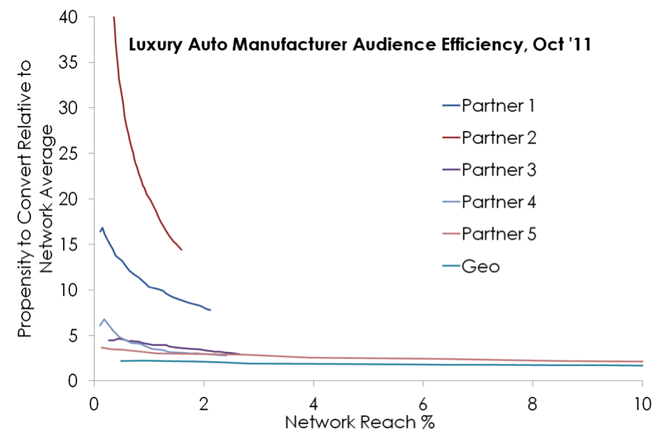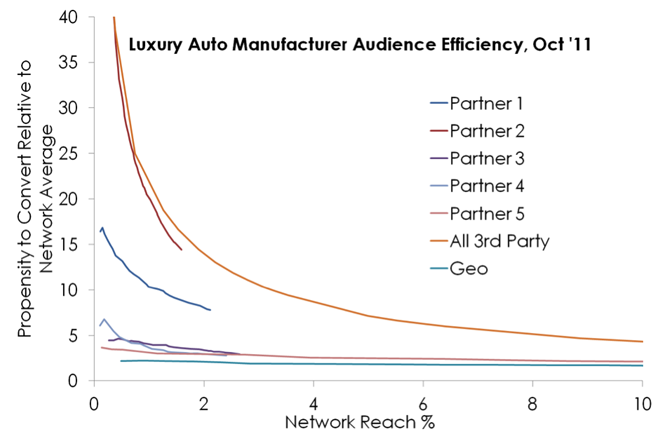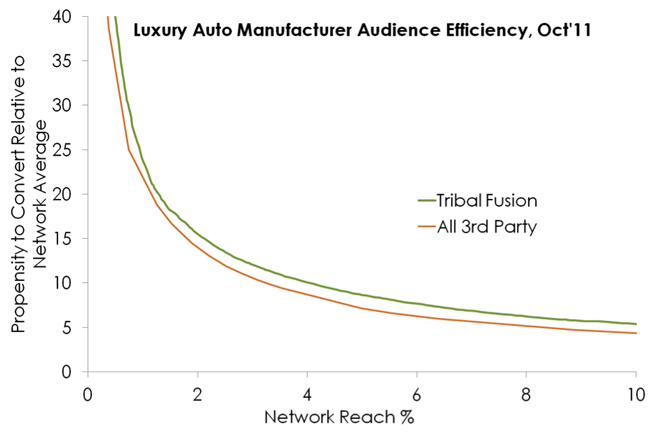_0.png)
I spoke the other week at AdMonsters OPS Markets London on the subject of audience efficiency. This is a methodology both to evaluate individual segments relative to a target audience, usually client converters or visitors, and the most efficient way to describe that target. We posted a preliminary piece on this very site. I offered five key findings based on more than 200 client models in my presentation and want to share three of those findings, and their implications, here.
A Reminder on Audience Efficiency
We can visualise audience efficiency as a tradeoff between how well an audience segment fits a client’s target audience (lift) and the reach. Mathematically, there is no possible selection of audiences that provides the same lift for a given reach or vice versa.
Third-Party Audiences Aren’t Efficient on Their Own
In this luxury auto manufacturer example we see that different third parties have radically different audience efficiency characteristics. At one extreme, we see that partner 2 has very high lift but very low reach. Partner 2’s total audience reach is higher than this, of course, but these are the only segments that show up as statistically relevant to this client target. At the other extreme, we see that partner 5 has very low lift, just 1 to 2 times the network average, though with very high reach.
What about partner 1? At first glance, it’s not that interesting. However, this is still a stunning result: for this auto manufacturer partner 1 describes 2% of the network, or 600,000 people, that have are 8 times more likely to convert relative to the network average. Offline segmentation is often happy with 2 or 3 times lift relative to the average!

This analysis tells us a few things about our partners:
- Work with data platforms that have access to multiple data sources in an “always on” way to be able to compare efficiency;
- Endemic in-market and interest-based audiences are most efficient;
- Socio-demographic sources can be useful but select your data partners and campaign objective-use cases carefully;
- Given the cost of building and maintaining “always on” links use this framework to optimise your partner portfolio – e.g. partner 5 won’t last much longer for us.

Aggregating Third-Party Audiences Can Be Efficient
But what if we run our audience Efficiency analysis across all the third parties rather than separately? The good news is that the whole is greater than the sum of the parts and it is possible to achieve more efficient audience models than any one source could provide on its own.
For advertisers and publishers this is a great result: you don’t need your own data source to describe your targets efficiently… though I’ll caveat that by saying that the downside is that you never have exclusivity in that case. That is, almost anyone else can be targeting the exact same audience segment as you and often for the same, or for competitive, brands.
What You Do Online Is More Important Than Who You Are Offline
A cryptic finding? From more than 200 client models we have seen that analysing our second-party data on its own tends to provide a more efficient audience than third-party data. Given that the third-party data is skewed to socio-demographic sources and that our second-party audience data is entirely interest-based, then we see that while offline data can be descriptive, your online interests are predictive.

We build our interest based audiences through running our proprietary page-level contextualisation across our data network and matching each page to one or more topics out of more than four thousand “leafs” from our topic tree. Visitors to those pages then have the topic added to their user profile for audience analytics and targeting.
The implication of this finding is that advertisers and publishers should focus on building interest-based audiences at scale for predictive efficiency and think about branded third-party audiences for descriptive efficiency. Intuitively, this shouldn’t be too surprising. Socio-demographics have only ever been a proxy to describe target audiences at a workable scale but ignore the subtleties of individual interests.
My address might suggest that I am a “Parish Guardian” or “Bright Young Thing” (those were the days) but it’s my current interests, in and around any purchase I might be considering, that predict my actions. Or as we said, what you do online is more important than who you are offline.